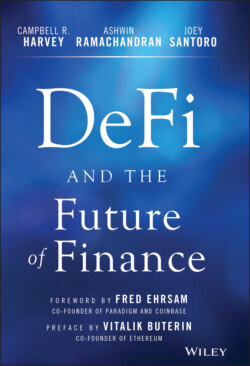Читать книгу DeFi and the Future of Finance - Campbell R. Harvey - Страница 18
STABLECOINS
ОглавлениеA crucial shortcoming of many cryptocurrencies is excessive volatility. This adds friction to users who wish to take advantage of DeFi applications but don't have the risk-tolerance for a volatile asset like ETH. To solve this, an entire class of cryptocurrencies called stablecoins has emerged. Intended to maintain price parity with some target asset, USD, or gold, for instance, stablecoins provide the necessary consistency that investors seek to participate in many DeFi applications and allow a cryptocurrency native solution to exit positions in more volatile cryptoassets. They can even be used to provide on-chain exposure to the returns of an off-chain asset if the target asset is not native to the underlying blockchain (e.g., gold, stocks, exchange-traded funds [ETFs]). The mechanism by which the stablecoin maintains its peg varies by implementation. The three primary mechanisms are fiat-collateralized, crypto-collateralized, and non-collateralized stablecoins.
By far the largest class of stablecoins are fiat collateralized. These are backed by an off-chain reserve of the target asset. Usually they are custodied by an external entity or group of entities that undergo routine audits to verify the collateral's existence. The largest fiat-collateralized stablecoin is Tether5 (USDT) with a market capitalization of $62 billion, making it the third largest cryptocurrency behind Bitcoin and Ethereum at time of writing. Tether also has the highest trading volume of any cryptocurrency but is not audited.6 The second largest is USDC,7 and its holdings of USD are regularly audited. USDC is redeemable 1:1 for USD and vice versa for no fee on Coinbase's exchange. USDT and USDC are very popular to integrate into DeFi protocols as demand for stablecoin investment opportunities is high. There is an inherent risk to these tokens, however, as they are centrally controlled and maintain the right to blacklist accounts.8
The second largest class of stablecoins are crypto-collateralized, meaning they are backed by an overcollateralized amount of another cryptocurrency. Their value can be hard or soft pegged to the underlying asset depending on the mechanism. With a market capitalization of $5 billion as of writing, the most popular crypto-collateralized stablecoin is DAI, created by MakerDAO9 and and backed by ETH and other crypto assets. It is soft pegged with economic mechanisms that incentivize supply and demand to drive the price to $1. We will do a deep dive into MakerDAO and DAI in Chapter 6. Another popular crypto-collateralized stablecoin is sUSD, which is hard pegged to $1 through the Synthetix10 network token (SNX) exchange functionality. Crypto-collateralized stablecoins have the advantages of decentralization and secured collateral. The drawback is that their scalability is limited. To mint more of the stablecoin, a user must necessarily back the issuance by an overcollateralized debt position. In some cases like DAI, a debt ceiling further limits the supply growth.
The last and perhaps most interesting class of stablecoins are non-collateralized. Not backed by any underlying asset and using algorithmic expansion and supply contraction to shift the price to the peg, they often employ a seigniorage model where the token holders in the platform receive the increase in supply when demand increases. When demand decreases and the price slips below the peg, these platforms issue bonds of some form, which entitle the holder to future expansionary supply before the token holders receive their share. This mechanism works almost identically to the central bank associated with fiat currencies, with the caveat that these platforms have an explicit goal of pegging the price rather than funding government spending or other economic goals. A noteworthy early example of an algorithmic stablecoin is Basis,11 which had to close due to regulatory hurdles. Current examples of algorithmic stablecoins include Ampleforth (AMPL)12 and Empty Set Dollar (ESD).13 The drawback to non-collateralized stablecoins is that they have a lack of inherent underlying value backing the exchange of their token. In contractions, this can lead to “bank runs,” in which many holders are left with large sums of the token that are no longer worth the peg price.
There is still much work to be done – and regulatory hurdles to overcome – in creating a decentralized stablecoin that both scales efficiently and is resistant to collapse in contractions.14 Stablecoins are an important component of DeFi infrastructure because they allow users to benefit from the functionality of the applications without risking unnecessary price volatility.
